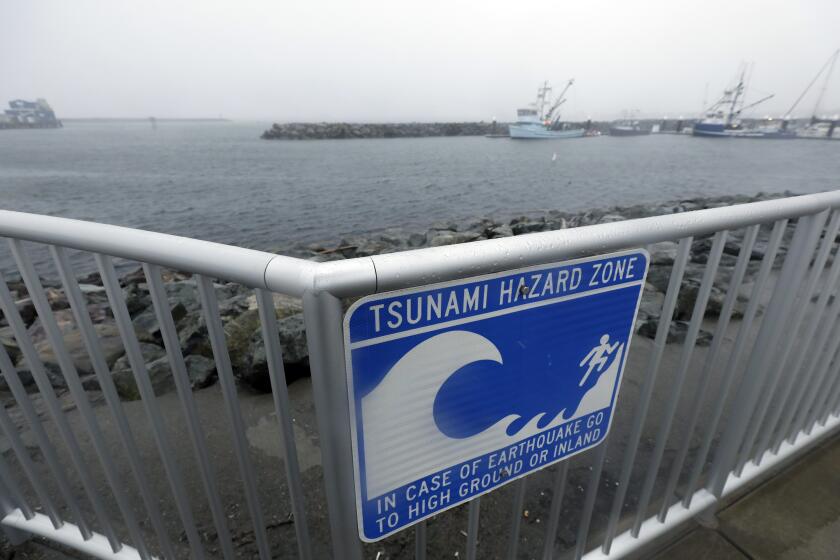Where in Northern California is most at risk for tsunami flooding? Check these maps

A major tsunami could swamp significant swaths of the Northern California coastline, according to hazard maps reviewed by The Times, making it vital for residents to know whether they live in an at-risk area and what to do should the threat arise.
Some of the most storied sections of San Francisco — including the Financial District, the Ferry Building, Fisherman’s Wharf, the Palace of Fine Arts, Chase Center, Oracle Park, the Zoo and Treasure Island — could see flooding from a major tsunami. The same is true for much of Alameda; sizable chunks of Oakland, Berkeley, Richmond and Marin County; and some areas near Silicon Valley, including northern sections of Redwood City and Burlingame.
To the south, some coastal communities along Highway 1 in San Mateo County are in a tsunami hazard zone — such as parts of Pacifica and Half Moon Bay — as are other popular tourist destinations in counties farther south, like the cities of Santa Cruz, Capitola and Monterey.
The risk extends north, too. Humboldt and Del Norte counties have significant tsunami risk. Crescent City, near the Oregon border, is the site of California’s worst tsunami disaster in modern times, and there are vast areas around Eureka, which is next to Humboldt Bay, where there are long, skinny peninsulas that could make an evacuation challenging.
A tsunami warning was issued across Northern California on Thursday morning following a magnitude 7 earthquake. It’s a reminder to prepare and know how to respond in case of such emergencies.
Tsunamis remain rare in California. And even if one materializes, it’s certainly possible not the entire hazard zone would flood. There are many scenarios where a tsunami could be forecast with many hours of warning, and the most at-risk areas would be limited to beaches and harbors.
The risk could be widespread, however. Earlier this month, a tsunami warning covering most of coastal Northern California was issued after a magnitude 7.0 quake struck off Humboldt County. That quake hit so close to shore that officials said they had only a matter of minutes to decide whether to an issue a warning.
A tsunami ultimately didn’t materialize, but many areas still had to be evacuated on short notice — demonstrating how, in the case of a real emergency, time would be of the essence.
In Humboldt County, a major quake that occurs nearby could produce a tsunami surge arriving as soon as 10 minutes after the shaking, according to county documents.
A nightmare scenario for Northern California, as well as Oregon and Washington, would be a magnitude 9 earthquake along the Cascadia subduction zone off the coast. A major quake there could bring a tsunami to San Francisco in as little as an hour. A rupture on an even closer fault, such as the Point Reyes thrust, could result in a tsunami hitting San Francisco in as few as 10 minutes, city documents show.
Coastal areas in Northern California began evacuating residents after a 7.0 earthquake off Humboldt County’s coast prompted a tsunami warning. Luckily, the worst didn’t play out. But emergency procedures were appropriately taken, officials said.
Tsunami hazard zones represent the maximum inundation area in a number of extreme yet realistic scenarios, according to the California Geological Survey. If you’re uphill or inland from the zones, you should be safe from tsunamis.
Those who live, work or recreate in a hazard zone should have an evacuation plan, though, especially since authorities may only have minutes to decide whether to order everyone to higher ground.
Officials say it’s also important to know if you’re not in a tsunami hazard zone to avoid complicating evacuations for those who need to move. There’s no need, for instance, to flee San Francisco when much of the city is in a safe zone — just walking a few blocks inland may be all that’s needed.
If you don’t know whether you’re in a tsunami hazard zone, and no maps or evacuation signs are available, officials recommend aiming for spots 100 feet above sea level and as far as two miles inland, if possible.
It’s important to remember that tsunamis are not like typical ocean waves. They are series of waves that reach shore almost like a turbulent wall of water or a fast-rising flood. You cannot surf a tsunami, and you should never try to watch one approach.
The science of catastrophe: tsunamis and how they work
And the first tsunami may not be the worst. During the catastrophic tsunami of 1964, which was generated by a magnitude 9.2 earthquake in Alaska, the first three surges that hit Crescent City were relatively small. The fourth, at 21 feet, was the largest, pushing all the way into the harbor, Nick Graehl, an engineering geologist with the California Geological Survey, said in a webinar last year.
By the time the fourth surge hit, people had actually returned to the city to start cleaning up. Eleven people died and hundreds of buildings were destroyed.
Here are maps showing some of Northern California’s most populated areas within a tsunami hazard zone, as determined by the California Geological Survey. The yellow section indicates the tsunami hazard area.
(A list of Southern California locations most at risk for flooding from a tsunami can be found here.)
In Crescent City, there are still reminders of the night when quake- caused waves killed 11 and washed away a good part of the town.
San Francisco
Downtown

Marina District

South-of-Market/Mission Bay areas

Southeastern neighborhoods

Richmond and Sunset districts

Treasure Island

The Bay Area shoreline
Oakland and Alameda

Berkeley and Richmond

Near Silicon Valley

Burlingame

Coastal San Mateo and Santa Cruz counties
Pacifica

Half Moon Bay

Santa Cruz and Capitola

Monterey County
Monterey

Moss Landing

Marin County


North Coast
Eureka and Humboldt Bay

Crescent City















